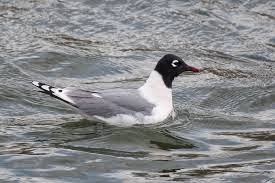It is finally here. From one warm day to three cold and windy days in a row, this did not seem like spring. It was eighty degrees yesterday and today it cooled but brought much needed rain and lots of it. Spring is here. The main evidence is the appearance of the Franklin's Gull. The corn fields to the south of our home were covered with the Gulls. A small black headed gull of the prairies, the bird follows the plowed fields and eats exposed worms, insects, and mice.
Whenever they come through, warm spring weather is on the way. They are coming through Iowa on their way to the nesting grounds of the northern Great Plains. Nesting in the extensive prairie marshes, colonies shift around annually till they find the right spot.
While they usually follow behind the tilling of the soil, the ground south of our home had been turned last fall. The farmer practices minimum tillage, and leaves a lot of trash from the harvest on the ground to hold in the moisture. This is then a great opportunity for insects and other creatures to make their home. The birds walk around on the ground and forage in the minimum tilled ground and find something to eat. The golf course lake nearby furnishes them the opportunity for wading and swimming.
In our area the gulls are just stopping to feast on the farm grounds and spend time on the lakes nearby. Then in a couple of days, they are gone heading up to their nesting grounds into Manitoba and Saskatchewan. In April they come through our location in Iowa and return on their way south in late September or early October.
I have read that they are considered, "flexible colony nesters." They shift colonies from year to year. The nests are actually floating nests made up of cattails, rushes and grasses. They are somewhat held in place by being attached to grass and other vegetation that is growing in the marsh.
The gull is a monogamous bird, and they both do the nesting. Mom and Dad build the nest and incubate the eggs for about 25 to 30 days. Both then feed the young and there is always one of the pair present. Remaining in the nest for about 3 weeks, the young will start swimming around. In approximately one month, they start to fly.
The gulls stayed with us for two days and then they were gone. We will look forward to seeing them again as they make the fall migration south.
Good hunting, good fishing, and good luck. Hank








.jpg)
No comments:
Post a Comment